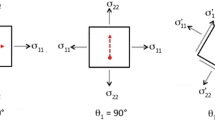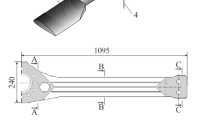Abstract
In order to ensure a valid damping measurement based on a proposed mathematical model, various laboratory techniques may be employed which require relatively simple instrumentation from which cross correlation of the data may be obtained.
Measurements were made (utilizing an accelerometer, strain gages, and a sound-level meter) under forced (3-dB frequency band or amplification factor Q) and free-vibration conditions at the fundamental and higher axial modes. Analysis (based on the viscous and complex-moduli theories) of the material damping of an aluminum alloy 2024-T4 in longitudinal vibrations shows good cross correlation between theories and experimental methods. These methods were extended to damping measurements of yellow brass and commercial steel. A multiple regression analysis was employed in the damping data reduction and was found to be useful in eliminating the data scatter. A sound-level meter was used as a noncontacting test method which proved useful even though its use does have drawbacks.
Similar content being viewed by others
Abbreviations
- A :
-
cross-section area (m2)
- B :
-
adiabatic bulk modulus (N/m2)
- C :
-
wave velocity (m/s)
- E :
-
elastic modulus (N/m2)
- E * :
-
complex modulus (N/m2)
- F o :
-
input force (N)
- f :
-
frequency (Hz)
- k 1 ,k d ,k s :
-
proportionality constant
- l :
-
length of the specimen (m)
- m :
-
attached mass (Kg)
- P :
-
sound pressure (N/m2)
- Q :
-
amplification factor
- Q 1 :
-
strain-amplification factor
- Q 2 :
-
displacement at the free end/displacement at the fixed end
- S :
-
displacement of a particle of the transmitting medium (m)
- t :
-
time (s)
- u :
-
displacement in specimen (m)
- U o :
-
peak amplitude of the displacement at the end point of a rod (m)
- x :
-
distance from a reference point (m)
- α:
-
damping coefficient due to surrounding fluid
- δ:
-
logarithmic decrement
- ε:
-
strain (m/m)
- \(\tilde \varepsilon\) :
-
dynamic strain (m/m)
- η:
-
damping loss factor
- λ:
-
wavelength (m)
- ρ:
-
density (Kg/m3)
- σ:
-
stress (N/m2)
- \(\tilde \sigma\) :
-
dynamic stress (N/m2)
- \(\bar \tau\) :
-
viscosity coefficient
- \(\phi _\eta\) :
-
phase angle (rad)
- Ω:
-
fundamental angular natural frequency (rad/s)
- \(\omega _n\) :
-
angular natural frequency (rad/s)
- \(\omega _1 ,{\text{ }}\omega _2\) :
-
angular frequency at 3 dB (rad/s)
References
Kolsky, H., Stress Waves in Solids, Dover Publication, Inc., New York (1963).
Snowdon, J. C., Vibration and Shock in Damped Mechanical Systems, John Wiley & Sons, Inc., New York (1968).
Lazan, B. J., Damping of Materials and Members in Structural Mechanics, Pergamon Press, Oxford, England (1968).
Maxwell, B., “An Investigation of the Dynamic Mechanical Properties of Polymethyl Methacrylate,”J. Pol. Sci.,20,551–556 (1956).
Adams, R. D., “The Damping Characteristics of Certain Steels, Cast Irons, and Other Metals,” J. of Sound and Vib., 199–216 (1972).
Bailey, R. R. andFahy, J., “Radiation and Response of Cylindrical Beams Excited by Sound,”J. of Eng. for Industry,94 (1),1 (1972).
Bordoni, P. G., “Elastic and Anelastic Behavior of Some Metals at Very Low Temperatures,”J. of the Acous. Soc. of Am.,26 (4),495–502 (1954).
Wegel, R. L. andWalther, H., “Internal Dissipation in Solids for Small Cyclic Strains,”J. Appl. Phys.,6,141–157 (1935).
Smith, T. L., Ferry, J. D. andShremp, F. W., “Measurements of Mechanical Properties of Polimer Solutions by Electro-Magnetic Transducer,”J. of Appl. Phys.,20,144 (1969).
Seto, W. W., Mechanical Vibrations, McGraw-Hill Book Company, New York (1964).
Lee, J. M., MS Thesis, Iowa State University, Ames, Iowa (1972).
Norris, D. M. andYoung, Wun-Chung, “Complex-modulus Measurement by Longitudinal Vibration Testing,”Experimental Mechanics,10 (2),93–96 (1970).
Beckwith, T. G. andBuck, N. L., Mechanical Measurements, Addison-Wesley, MA (1969).
Mason, W. P., Low- and High-Amplitude Internal Friction Measurements in Solids and Their Relation to Imperfection Motions in Microplasticity, edited by McMahon, C. J., Jr., Interscience Publishers (1968).
Lee, T. H., Adams, G. E. and Gaines, W. M., Computer Process Control: Modeling and Optimization, John Wiley & Sons, Inc. (1968).
Crandall, S. H., “On Scaling Laws for Material Damping,” NASA TN D 1467, 25 (1962).
Author information
Authors and Affiliations
Rights and permissions
About this article
Cite this article
Lee, J.M., McConnell, K.G. Experimental cross verification of damping in three metals. Experimental Mechanics 15, 347–353 (1975). https://doi.org/10.1007/BF02318875
Issue Date:
DOI: https://doi.org/10.1007/BF02318875




